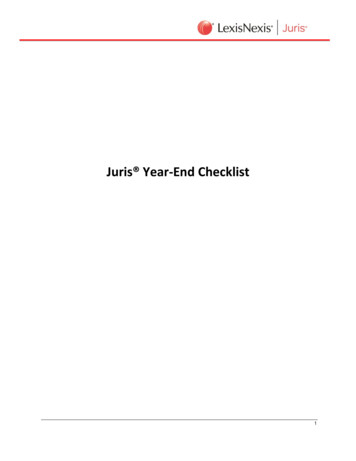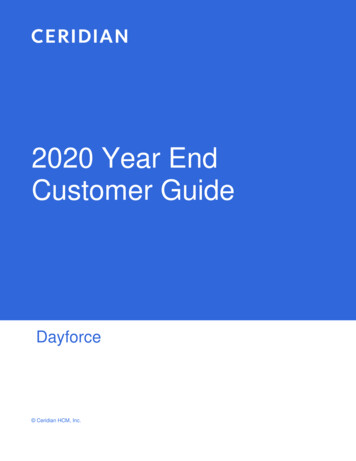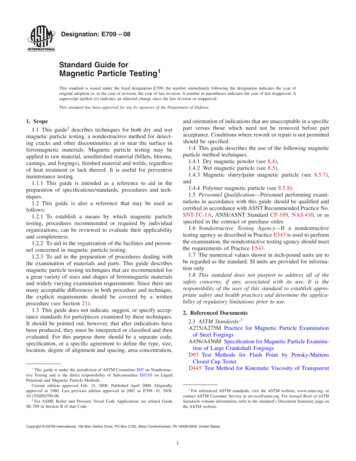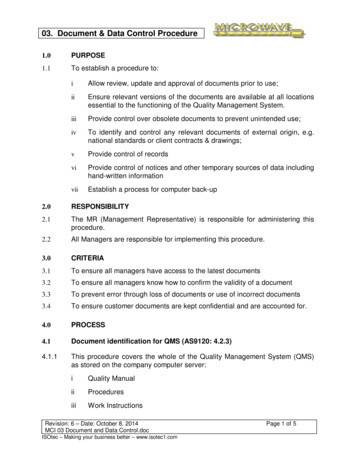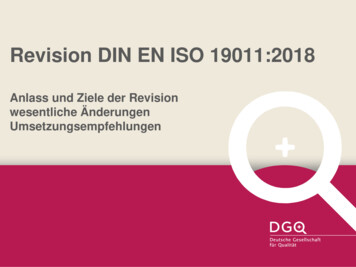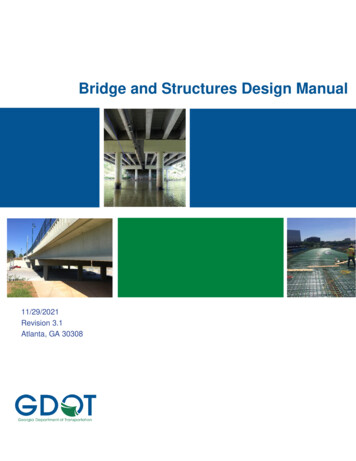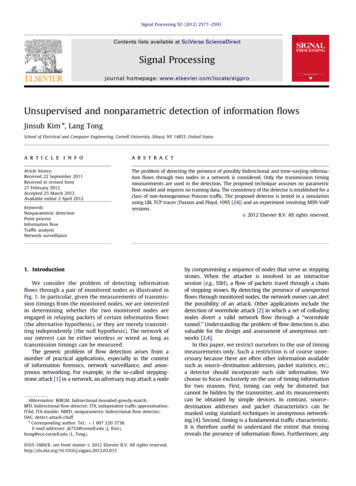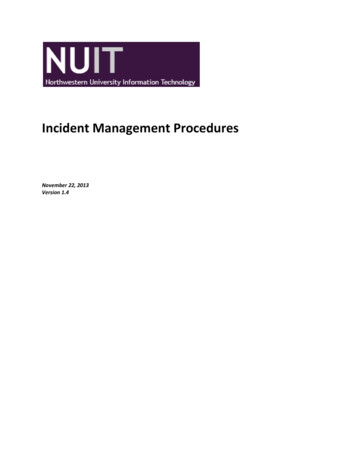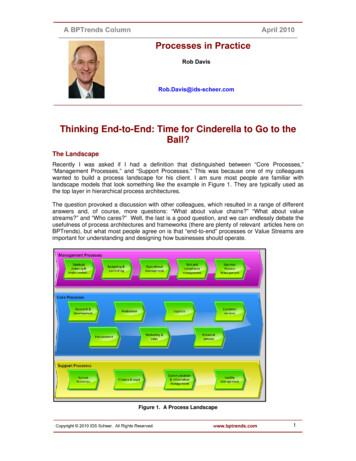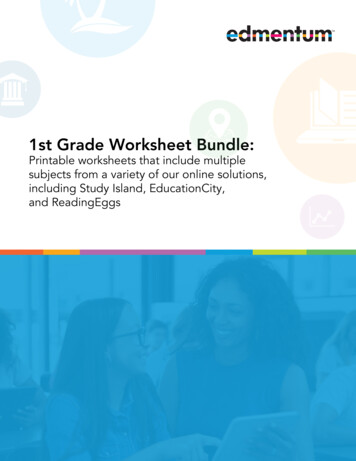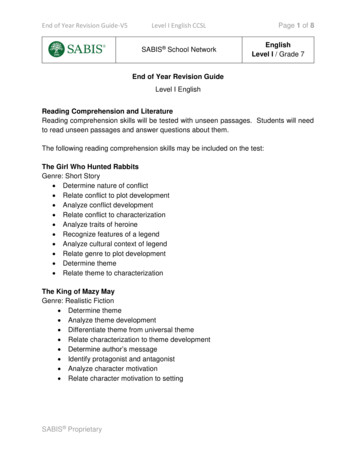
Transcription
End of Year Revision Guide-V5Level I English CCSLSABIS School NetworkPage 1 of 8EnglishLevel I / Grade 7End of Year Revision GuideLevel I EnglishReading Comprehension and LiteratureReading comprehension skills will be tested with unseen passages. Students will needto read unseen passages and answer questions about them.The following reading comprehension skills may be included on the test:The Girl Who Hunted RabbitsGenre: Short Story Determine nature of conflict Relate conflict to plot development Analyze conflict development Relate conflict to characterization Analyze traits of heroine Recognize features of a legend Analyze cultural context of legend Relate genre to plot development Determine theme Relate theme to characterizationThe King of Mazy MayGenre: Realistic Fiction Determine theme Analyze theme development Differentiate theme from universal theme Relate characterization to theme development Determine author’s message Identify protagonist and antagonist Analyze character motivation Relate character motivation to settingSABIS Proprietary
End of Year Revision Guide-V5Level I English CCSLRegionalism: Forming an American IdentityGenre: Academy Essay Recognize features of an academic essay Relate structure to topic Determine argument Identify counter-argument Identify thesis Relate thesis to main idea Summarize author’s argument Relate supporting information to thesis Relate supporting information to claims Relate specific sections to structure Analyze author’s purpose Determine author’s bias Analyze author’s tone Determine two or more central ideas Analyze development of central ideasThe California Gold Rush: Building America, Chasing DreamsThe Costs and Conflicts of the California Gold RushGenre: Realistic Nonfiction Determine author’s argument Determine claims within text Relate supporting evidence to claims Identify counter argument Determine alternative supporting evidence from text Determine author’s purpose Determine author’s point of view Recognize bias Analyze bias Relate author’s point of view to argument Evaluate supporting information in relation to argumentPaul Revere’s Ride: A Factual AccountGenre: Historical Essay: Determine structure of essay Relate structure to historical contentSABIS ProprietaryPage 2 of 8
End of Year Revision Guide-V5Level I English CCSLPaul Revere’s RideGenre: Narrative Poem Identify features of a narrative poem Relate poem features to narrative contentRing Out, Wild BellsGenre: Poetry Determine purpose of repetition Relate repetition to imagery Relate repetition to tone Relate repetition to messageO Captain! My Captain!Genre: Poetry - Elegy Identify features of an elegy Determine speaker’s tone in elegy Relate imagery to speaker’s tone and mood Relate genre to purpose Relate line position and placement to content Relate line position and placement to rhythm Determine purpose of line position and placement Analyze imagery of line position and placement Identify metaphors and extended metaphors Relate metaphors and extended metaphors to events described Relate symbols to meanings Analyze allegory in poemSonnet 43Genre: Poetry - Sonnet Identify type of sonnet Identify features of sonnet Relate structure of sonnet to meaning Determine tone of sonnet Relate rhythm and rhyme to meaningSABIS ProprietaryPage 3 of 8
End of Year Revision Guide-V5Level I English CCSLSilverGenre: Poetry Identify mood Determine tone Relate word choice to tone Analyze connections between mood and tone Compare and contrast alliteration and rhyme Analyze effects of alliteration on meaning Analyze effects of alliteration on mood Identify personification Relate personification to speaker’s point of view Analyze effects of personification on theme Analyze connections between word choice and imagery Relate imagery to mood Relate imagery to theme Relate imagery to speaker’s point of viewTaming the BicycleGenre: Essay Identify features of an essay Identify thesis Analyze development of main idea or argument Relate evidence to ideas Relate structure to purpose Identify author’s argument Relate evidence to argument Relate evidence to claims Determine relevancy of information Relate structure to argument Determine author’s purpose Analyze author’s point of view Relate rhetorical devices to purposeSABIS ProprietaryPage 4 of 8
End of Year Revision Guide-V5Level I English CCSLThe Need for HumilityGenre: Persuasive Essay Determine purpose of essay Identify bias Determine argument Analyze emotional and ethical appeals Relate rhetorical devices to purpose Determine tone of essay Analyze meaning and effect of metaphorMohandas Gandhi: The Father of IndiaGenre: Biography Identify characteristics of biography Determine structure of biography Relate structure to purpose Differentiate objective from subjective point of view Determine point of view Relate point of view to author’s purpose Evaluate author’s claims Identify supporting evidenceSpring FestivalsGenre: Cultural Essay Analyze the features of a cultural essay Relate descriptive structure to features of a cultural essay Analyze connections between ideas and events Relate structure to author’s purpose Analyze relationship between text sections and topic Relate details to key ideas Summarize key ideas in text Compare and contrast key ideasSABIS ProprietaryPage 5 of 8
End of Year Revision Guide-V5Level I English CCSLPage 6 of 8Discovering the Earth: HotspotsGenre: Scientific Article Identify scientific question in article Determine central idea Evaluate supporting evidence Identify author’s purpose Determine purpose of information Identify main idea of paragraphs Relate supporting details to main ideaThe GiverGenre: Novel Determine main idea and supporting details Identify and describe characters’ traits, actions, and motivations Identify events and conflicts Compare and contrast characters, settings, and events Recognize chapters and relate to plotThe Diary of Anne FrankGenre: Drama Identify and describe characters’ traits, actions, and motivations Identify events and conflicts Compare and contrast characters, settings, and events Recognize chapters and relate to plotVocabulary Be familiar with all vocabulary words from the stories Be able to recognize the words used in context When given a choice of words, be able to fill in a blank of an incomplete sentencewith an appropriate vocabulary word Be able to match words and definitions from a list When given a list of vocabulary words, be able to select some of the words anduse each word in an original sentence that demonstrates its meaning Be able to identify the correct synonym and antonym of a given word Be able to choose the correct definition using context cluesSABIS Proprietary
End of Year Revision Guide-V5Level I English CCSLPage 7 of 8The Girl Who Hunted RabbitsbarterprocuredconcealmentreverentlyO Captain! My Captain!exultingportmournfulwreathsRegionalism: Forming an AmericanIdentityencapsulateinaneperpetuateSonnet 43idealstriveSilvergleamreedsscamperingthatchThe King of Mazy he California Gold Rush: BuildingAmerica, Chasing DreamscultivateingenuityflourishedvibrantThe Costs and Conflicts of theCalifornia Gold RushdepletednotoriouslyferventretaliatedPaul AprosperousreconstructvitalPaul Revere’s RideimpetuousstealthyRing Out, Wild BellsfoulslanderstrifespiteSABIS ProprietaryFactualTaming the ttishsteepedThe Need for elationinsolentMohandas Gandhi: The Father of primarySpring dopticalunscathedDiscovering the Earth: ulative
End of Year Revision Guide-V5Level I English CCSLPage 8 of 8WritingWrite a response to literature essay. You will be provided with two prompts about TheDiary of Anne Frank. You will need to respond to one of the prompts using one of theessay styles that you learnt this year. You will also be provided with a rubric that you canuse to construct your essay. You will use a few minutes at the end of the test to neatlymake revisions and corrections. Your text will be graded on the following writing traits: IdeasOrganizationFluency and Word ChoiceConventions of Standard EnglishGrammar Unit 3: Tenses and Voice: Perfect Progressive, Tenses and Passive Voice Unit 4: Adverbs and Adjectives: Types and Degrees Unit 5: Prepositions and Phrases Unit 6: Aspects of Nouns: Abstract, Collective, Plural, Gerund Unit 7: Pronouns: Personal, Indefinite, Relative Unit 8: Verbs: Action, Helping, Modal, Linking, Conditional Unit 9: Constructing Sentences Unit 10: Deconstructing and Linking Sentences Unit 11: General Punctuation Unit 12: Speech and Reported Speech Unit 13:Error Correction Appendix 2: List of Irregular Verbs Appendix 3: The Forms of to be Appendix 4: Adjectives with Prepositions Appendix 5: InterjectionsSABIS Proprietary
End of Year Revision Guide-X3ENI1X English CCSLSABIS School NetworkPage 1 of 7EnglishENI1X / Grade 7End of Year Revision GuideENI1X EnglishReading Comprehension and LiteratureReading comprehension skills will be tested with unseen passages. Students will needto read unseen passages and answer questions about them.The following reading comprehension skills may be included on the test:The King of Mazy MayGenre: Realistic Fiction Determine theme Analyze theme development Differentiate theme from universal theme Relate characterization to theme development Determine author’s message Identify protagonist and antagonist Analyze character motivation Relate character motivation to settingRegionalism: Forming an American IdentityGenre: Academy Essay Recognize features of an academic essay Relate structure to topic Determine argument Identify counter-argument Identify thesis Relate thesis to main idea Summarize author’s argument Relate supporting information to thesis Relate supporting information to claims Relate specific sections to structure Analyze author’s purpose Determine author’s bias Analyze author’s tone Determine two or more central ideas Analyze development of central ideasSABIS Proprietary
End of Year Revision Guide-X3ENI1X English CCSLThe California Gold Rush: Building America, Chasing DreamsThe Costs and Conflicts of the California Gold RushGenre: Realistic Nonfiction Determine author’s argument Determine claims within text Relate supporting evidence to claims Identify counter argument Determine alternative supporting evidence from text Determine author’s purpose Determine author’s point of view Recognize bias Analyze bias Relate author’s point of view to argument Evaluate supporting information in relation to argumentPaul Revere’s Ride: A Factual AccountGenre: Historical Essay: Determine structure of essay Relate structure to historical contentPaul Revere’s RideGenre: Narrative Poem Identify features of a narrative poem Relate poem features to narrative contentRing Out, Wild BellsGenre: Poetry Determine purpose of repetition Relate repetition to imagery Relate repetition to tone Relate repetition to messageSABIS ProprietaryPage 2 of 7
End of Year Revision Guide-X3ENI1X English CCSLO Captain! My Captain!Genre: Poetry - Elegy Identify features of an elegy Determine speaker’s tone in elegy Relate imagery to speaker’s tone and mood Relate genre to purpose Relate line position and placement to content Relate line position and placement to rhythm Determine purpose of line position and placement Analyze imagery of line position and placement Identify metaphors and extended metaphors Relate metaphors and extended metaphors to events described Relate symbols to meanings Analyze allegory in poemSonnet 43Genre: Poetry - Sonnet Identify type of sonnet Identify features of sonnet Relate structure of sonnet to meaning Determine tone of sonnet Relate rhythm and rhyme to meaningSilverGenre: Poetry Identify mood Determine tone Relate word choice to tone Analyze connections between mood and tone Compare and contrast alliteration and rhyme Analyze effects of alliteration on meaning Analyze effects of alliteration on mood Identify personification Relate personification to speaker’s point of view Analyze effects of personification on theme Analyze connections between word choice and imagery Relate imagery to mood Relate imagery to theme Relate imagery to speaker’s point of viewSABIS ProprietaryPage 3 of 7
End of Year Revision Guide-X3ENI1X English CCSLTaming the BicycleGenre: Essay Identify features of an essay Identify thesis Analyze development of main idea or argument Relate evidence to ideas Relate structure to purpose Identify author’s argument Relate evidence to argument Relate evidence to claims Determine relevancy of information Relate structure to argument Determine author’s purpose Analyze author’s point of view Relate rhetorical devices to purposeThe Need for HumilityGenre: Persuasive Essay Determine purpose of essay Identify bias Determine argument Analyze emotional and ethical appeals Relate rhetorical devices to purpose Determine tone of essay Analyze meaning and effect of metaphorMohandas Gandhi: The Father of IndiaGenre: Biography Identify characteristics of biography Determine structure of biography Relate structure to purpose Differentiate objective from subjective point of view Determine point of view Relate point of view to author’s purpose Evaluate author’s claims Identify supporting evidenceSABIS ProprietaryPage 4 of 7
End of Year Revision Guide-X3ENI1X English CCSLSpring FestivalsGenre: Cultural Essay Analyze the features of a cultural essay Relate descriptive structure to features of a cultural essay Analyze connections between ideas and events Relate structure to author’s purpose Analyze relationship between text sections and topic Relate details to key ideas Summarize key ideas in text Compare and contrast key ideasDiscovering the Earth: HotspotsGenre: Scientific Article Identify scientific question in article Determine central idea Evaluate supporting evidence Identify author’s purpose Determine purpose of information Identify main idea of paragraphs Relate supporting details to main ideaThe GiverGenre: Novel Determine main idea and supporting details Identify and describe characters’ traits, actions, and motivations Identify events and conflicts Compare and contrast characters, settings, and events Recognize chapters and relate to plotThe Diary of Anne FrankGenre: Drama Identify and describe characters’ traits, actions, and motivations Identify events and conflicts Compare and contrast characters, settings, and events Recognize chapters and relate to plotSABIS ProprietaryPage 5 of 7
End of Year Revision Guide-X3ENI1X English CCSLPage 6 of 7Vocabulary Be familiar with all vocabulary words from the stories Be able to recognize the words used in context When given a choice of words, be able to fill in a blank of an incomplete sentencewith an appropriate vocabulary word Be able to match words and definitions from a list When given a list of vocabulary words, be able to select some of the words anduse each word in an original sentence that demonstrates its meaning Be able to identify the correct synonym and antonym of a given word Be able to choose the correct definition using context cluesRegionalism: Forming an AmericanIdentityencapsulateinaneperpetuateO Captain! My Captain!exultingportmournfulwreathsThe King of Mazy he California Gold Rush: BuildingAmerica, Chasing DreamscultivateingenuityflourishedvibrantThe Costs and Conflicts of theCalifornia Gold RushdepletednotoriouslyferventretaliatedPaul AprosperousreconstructvitalPaul Revere’s RideimpetuousstealthySABIS ProprietaryRing Out, Wild BellsfoulslanderstrifespiteFactualSonnet g the ttishsteepedThe Need for elationinsolent
End of Year Revision Guide-X3ENI1X English CCSLMohandas Gandhi: The Father of primarySpring FestivalsallegedlyexuberancefrivolitylavishPage 7 of 7Discovering the Earth: ulativeheraldedopticalunscathedWritingWrite a response to literature essay. You will be provided with two prompts about TheDiary of Anne Frank. You will need to respond to one of the prompts using one of theessay styles that you learnt this year. You will also be provided with a rubric that you canuse to construct your essay. You will use a few minutes at the end of the test to neatlymake revisions and corrections. Your text will be graded on the following writing traits: IdeasOrganizationFluency and Word ChoiceConventions of Standard EnglishGrammar Unit 3: Tenses and Voice: Perfect Progressive, Tenses and Passive Voice Unit 4: Adverbs and Adjectives: Types and Degrees Unit 5: Prepositions and Phrases Unit 6: Aspects of Nouns: Abstract, Collective, Plural, Gerund Unit 7: Pronouns: Personal, Indefinite, Relative Unit 8: Verbs: Action, Helping, Modal, Linking, Conditional Unit 9: Constructing Sentences Unit 10: Deconstructing and Linking Sentences Unit 11: General Punctuation Unit 12: Speech and Reported Speech Unit 13:Error Correction Appendix 2: List of Irregular Verbs Appendix 3: The Forms of to be Appendix 4: Adjectives with Prepositions Appendix 5: InterjectionsSABIS Proprietary
End of Year Revision PacketMathematics – Level ISABIS School NetworkPage 1 of 22MathematicsLevel IEnd of Year Revision PacketHighlights: Test for divisibility. Apply prime factorization to find the GCF and LCM of two or more numbers. Compare, add, subtract, multiply, and divide fractions, mixed numbers, and whole numbers. Represent repeating and terminating decimals as ratios of integers. Add, subtract, multiply, and divide decimals. Simplify numeric and algebraic expressions. Compare positive and negative numbers.Define and recognize rational, irrational, natural numbers, whole numbers, integers, and realnumbers.Contrast the decimal representation of rational numbers with those of irrational numbers.Give the name of the set of numbers that is formed by the union of the irrational and therational numbers.Apply the axioms of real numbers to simplify expressions.Provide counterexamples to show that subtraction & division are neither commutative norassociative.Add, subtract, multiply, and divide real numbers expressed as fractions or decimals, placingspecial emphasis on working with negative numbers.Simplify algebraic expressions involving like terms.Simplify and evaluate expressions involving sums, differences, products, quotients, andexponents.Apply the rules of powers to simplify numeric and algebraic expressions.Find the solution set of a linear equation in one variable.Solve linear inequalities by adding, subtracting, multiplying, or dividing.Write algebraic expressions involving one or more operations or word phrases.Write algebraic expressions for word phrases with two related variables involving conceptssuch as area, perimeter, averages, quotients, products, differences, and sums.SABIS Proprietary
End of Year Revision PacketMathematics – Level IPage 2 of 22 Translate a word sentence into an algebraic sentence. Solve for the unknown.Solve word problems on topics such as age, money, speed, and perimeter by translating thewords to math equations or inequalities and solving them. Express the ratio of a and b as a fraction and as a decimal.Express a ratio in its simplest form.Find the unit ratio equivalent to a given ratio.Find quantities given their ratios.Use the cross-multiplication property to solve for an unknown in a proportion.Solve word problems involving proportions.Convert between percents, ratios, fractions, and decimals.Given a% of b is c, solve for an unknown.Solve word problems on profit, loss, discount, taxes, percent change, percent error, andsimple interest. Recognize a direct variation/proportionality. Given one instance, find another.Graph direct variations.Solve word problems on rate and speed.Calculate rates of change.Solve problems involving direct proportionality.Estimate actual distances by reading a map.Identify the x-intercept, y-intercept, and slope of a line of a linear relation.Work with arithmetic and geometric progressions.Find compound interest.Find the rule for a table of values. Recognize patterns. Work with adjacent, vertical, congruent, complementary, and supplementary angles.Define a circle and its basic elements.Work with quadrilaterals including parallelograms, trapezoids, rectangles, rhombuses, andsquares.Recognize polygons and triangles.Recognize parallel, intersecting, and perpendicular planes.Identify 3-D figures, and work with cross-sections. Find the perimeters of plane figures.Find the circumference of a circle.Find the areas of triangles, parallelograms, rectangles, and squares.Find areas of circles and composite shapes.Work with scale drawings.Use and apply the criteria and properties of similarity in triangles.Perform dilations.SABIS Proprietary
End of Year Revision PacketMathematics – Level IPage 3 of 22 Find the surface areas and volumes of right prisms.Solve problems on volume and surface area. Calculate and use the measures of spread of a data set.Interpret the data displayed in different types of graphs.Use the visual properties of box-and-whisker plots to analyze sets of spread data.Group and organize continuous data in a frequency table and draw a histogram.Given a survey, identify the population and the size of a sample.Identify a random sample and ways of sampling to ensure randomness. Understand thebenefit of sampling and collecting data properly.Identify random and fair samples. Recognize that data represented in the absolute form, asopposed to relative, might be misleading. Use organized lists, tables, and tree diagrams to list the different possible outcomes in agiven context.Use the fundamental principle of counting to find the total number of outcomes in a givencontext.Use adequate counting techniques to find the probability of an event.Analyze and solve word problems involving probability and counting.Determine probabilities based on previous experience.Discuss the consistency and reasonableness of experimental outcomes and predictions.Judge the fairness of a game.Interpret the result of a simulation.SABIS Proprietary
End of Year Revision PacketMathematics – Level IPage 4 of 22Vocabulary: Natural numbers, Whole numbers, Divisibility, Exponent, Base, Factor, Prime number,Composite number, Relatively prime, Prime factorization, GCF, LCM, Multiple Fractions, Equivalent fractions, Comparing fractions, Improper fractions, Mixed numbers,Reciprocal, Number line Decimal fractions, Tenths, Hundredths, Thousandths, Place value, Value Algebraic expression, Numeric expression, Variables, Substitution principle, Domain of avariable, Formulas, Evaluate, Negative numbers, Integers, Real numbers, Rational numbers,Irrational numbers, Order Axioms, Theorems, Axioms of equality, Reflexive axiom, Symmetric axiom, Transitiveaxiom, Closure axioms of addition and multiplication, Commutative axioms of addition andmultiplication, Associative axioms of addition and multiplication, Identity axiom ofaddition, Axiom of additive inverses, Identity axiom of multiplication, Axiom ofmultiplicative inverses, Distributive axiom Numerical coefficient, Like/similar terms, Simplify, Property of the opposite of a sum,Property of opposites in products, Product property of quotients Power, Absolute value, Order of operations, Scientific notation Equation, Solution set, Solve, Inverse operations, Addition property of equality,Multiplication property of equality, Inequality Word phrases, Plus, Added to, Incremented, Sum, Total, More than, Increased by, Minus,Subtracted from, Less than, Decreased by, Reduced by, Diminished by, Difference, Times,Multiplied by, Product, Double of, Twice, Divided by, Quotient, Unknown Ratio, Equivalent ratios, Unit ratios, Proportion, Cross-multiplication property Percentage, Profit, Loss, Discount, Tax, Percent change, Errors in measurement, Simpleinterest Direct variation, Proportionality, Table, Vary, Coordinate plane, Graph Rate, Unit pricing, Speed, Scale, Map Pattern, Rule, Arithmetic progression, Geometric Progression, Slope Angles, Complementary, Supplementary, Lines, Intersecting, Perpendicular, Polygon,Trapezoid, Rectangle, Rhombus, Square, Triangle, Circle, Basic elements, Constructions,3-D figures, Cross-sections, Nets Perimeter, Circumference, Area, Scale drawing, Similar, Similarity, Dilation, Volume,Surface area Set of data, Mean, Mode, Median, Range, Line plot, Stem-and-leaf plot, Bar graph,Box-and-whisker plot, Line graph, Circle graph, Histogram, Survey, Sampling, Bias Tree diagrams, Fundamental principle of counting, Probability, Fair, SimulationSABIS Proprietary
End of Year Revision PacketMathematics – Level IPage 5 of 22Level I Revision Exercises:Ch. 1Section 1Essentials of ArithmeticNatural Numbers1. Find the greatest common factor and the least common multiple of each pair of numbers.a) 16 and 32Section 2b) 1 and 50Fractions2. Add or subtract. Express your answer in simplest form, or as a mixed number if necessary.a)3 2 8 57 5 8 12b)c) 71317 220203. Multiply or divide. Express your answer in simplest form, or as a mixed number if necessary.a)8 515d) 8 2b)72 32 96 48c) 6 3f) 2 22443e) 3 577341736151liters of orange juice with liter of peach juice and 1 liters of carrot juice.2481She plans to serve the mix in glasses ofliter. How many such glasses can she serve?44. Mona mixed 1Section 3Representation of Decimals5. Round to the nearest whole number.a) 23.91Section 4b) 23.42c) 23.5Operations With Decimals6. Compute.a) 0.9 0.5b) 1.2 0.08c) 61 54.3 7.91d) 3 0.02e) 8.4 17f) 6.28 47. Without dividing, tell whether each division results in a non-terminating decimal quotient.a) 15 9SABIS Proprietaryb)1120c) 30 12
End of Year Revision PacketMathematics – Level IPage 6 of 228. A tablespoon of honey contains 64.5 calories. How many calories are there in 3 tablespoons ofhoney?Section 5Simplifying Numerical Expressions9. Simplify.a) 30 5 1 2 5 – 3 2b) 30 5 [(1 2) 5 – 3] 2c) 100 – [15 3 (28 – 8)]d) (25.5 – 20 – 5) (10 4)e) 50 – 42 1.5f) 92 – (102 – 4 7)g)11 1 2 12 4 3Section 6h)91 2 1048Algebraic and Numerical Expressions25 when a 3 .45a 10. EvaluateChapter SummaryChapter TestCh. 2Section 1TB read pages 52-55TB pages 56-58The Set of Real NumbersNegative Numbers11. Write the numbers in order from least to greatest.a) 0.75, 1.25, 1.25, 1.75, 2.251111111b) , , 3 , 5 , 3 , , 1222222212. Simplify.a) – ( 5.3)SABIS Proprietaryb) – (–15) 19 c) 2 d) – [– (–10)]
End of Year Revision PacketSection 2Mathematics – Level IPage 7 of 22Rational Numbers13. Without the use of a calculator, write 0.777 as a fraction in lowest terms.Section 4Axioms of Real Numbers14. Simplify.a) 2b[4(b 3) 5(4 3b) 6b] 4[5b 3(2b 7)]b) 7[3x2 (x2 x 5)] 2[2(x2 x 7) 2x]c)2 x 3x x 74 2d)31( 6 x 4) ( 2 8x )22TB read pages 86-88TB pages 89, 90Chapter SummaryChapter TestCh. 3Section 1Operations on Real NumbersAddition of Real Numbers15. Add.a) 15 ( 20)b) 8 ( 8)c) –10 3 3 1 d) 2 2 e) –2 (–8.1) 4 4f) 5 5Section 2Subtraction of Real Numbers16. Subtract.a) 12 – ( 5)b) 10 – ( 10)c) 7 – ( 7)d) 0.9 – 2e) 8 – 8f) –10 – 4g) –13 – (–6)h) 6 – 7.517. The price of a share of a certain stock is 18 on Friday. By Monday, it shows a change of —5.Use a number line to find the new price of this share. Did the price of the share increase ordecrease?SABIS Proprietary
End of Year Revision PacketSection 3Mathematics – Level IPage 8 of 22Multiplication of Real Numbers18. Simplify.a) 4( 8)b) 6( 12)c) 3( 11)d) 5 2.1e) 6( 2)( 5)f) 3( 0.5)g) 3(3)( 14)h) 17(3)( 1)Section 4Division of Real Numbers19. Simplify.a) 51 (–17)b) (–48) 6d) (–335) ( 5)e)c) 121 ( 11) 34 43 3 f) 12 4 20. What is the average of six negative integers and their opposites? Explain how you got youranswer.Section 5Simplifying Numerical Expressions21. Simplify.a) ( 8 15) 5d)7 1 1 1 10 3 5 2 Section 6b) 9 [14 ( 12)]c) ( 12 6) 2e) 21 [81 ( 31)]f) 4 (–3 5)2 – 103Simplifying Algebraic Expressions22. Simplify.a) ( 10a 3) 14ab) 7 ( 7b 14)c) –2(5 – 4a) – 3(5a 13)d)1( 2 8 x ) 16 x223. Evaluate the expressions for x –6 and y –2.a) 5(2x – 3y)b) 5x( 8 3y)24. Write each expression as a product of two factors, one of which is the GCF of the numericalcoefficients of the terms.a) 50x – 15y 5SABIS Proprietaryb) –30x – 95
End of Year Revision PacketSection 7Mathematics – Level IPage 9 of 22Powers25. Simplify.a) 6 52 64 42 15(90)b) 2 32 5 24c) 53 5 2 43 4 (12 10 )026. What is the value of the missing exponent?a7 a) 15 aa1 b) 6 bb,a 0TB read pages 145, 146TB pages 147-149Chapter SummaryChapter TestCh. 4Section 1,b 0Linear Equations and Inequalities in One VariableEquations27. Find the solution set of the equation over the domain D.If the equation has no solution, indicate so.a) 3a 81, D {3, 4}Section 2b) 3a 81, D {3, 4}Solving Equations of t
Genre: Novel Determine main idea and supporting details Identify and describe characters’ traits, actions, and motivations Identify events and conflicts Compare and contrast characters, settings, and events Recognize chapters and relate to p
